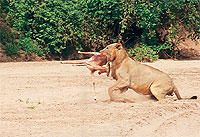 |
| A young male makes off with the bait whilst the pride male remains out of sight (Photo: H.H.K. Safaris). |
|
The story goes, that under the heading “Eland Stew” in the cook book, the first essential is “find your eland”. Hunting lion requires this first step as well. It is no good festooning the countryside with baits until you are sure that there are lion in the vicinity. Once you have seen spoor, heard them calling or detect vultures circling over an area, you at least have a starting point. Lion are fairly nomadic in their habits and tend to follow the most easily accessible routes like road paths and watercourses. Consequently these are the areas to concentrate on when first looking for lion.
When preparing to bait a location there are a few basic essentials that need to be considered, and where possible adhered to, when choosing your site and preparing your bait.
Ideally, your bait should be in the vicinity of water, although too close could mean your lion lies up close to the water rather than your bait. He must be encouraged to drink and then return to guard his meal against outsiders.
The chief outsiders are of course hyena and vultures. Should your bait be too low, rest assured that it will be devoured up as far as a hyena can leap, at least 1.8 metres off the ground for the lower end of your bait. Bear in mind that a lion, when he stands on his back legs, can reach up to at least two metres with his jaws.
Vultures can be countered by piling some leafy/thorny branches on top of the bait, and/or tying a shiny object on the bait out of sight of the lion’s gaze. Tin foil has its uses out of the kitchen! It will deter the scavengers especially if it moves with the breeze.
The bait tree needs to be fairly robust to take the weight of your offering. Obviously you have to work with what you have available in the way of meat, but in order to detain a hungry male lion, or possibly more than one, you need to be able to present a substantial meal. (Most hunts for lion will involve shooting a buffalo as well. If a hippo or elephant are to be hunted, they too provide good bait).
Therefore, a half buffalo suspended at a height which allows a large male to feed with difficulty is a good bet. Try and suspend the bait so that it is able to move when the lion attempts to eat. There needs to be a balance between difficulty and ease of eating, otherwise if it becomes too difficult, he will move off to greener pastures. I prefer to use chain and D-shackles or good trek chains that can be locked in position to secure the bait. They don’t fray, twist out of shape or leave unsightly tangles of wire scattered around the bush. If it is too easy, he or they will finish the meat and move on before you arrive to take up your position in the blind.
|